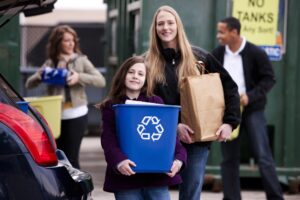Curbside Recycling Made Easy
Recycling as much of your garbage as possible is the right thing to do for the environment and for future generations. Knowing what and how to recycle seem challenging at first, but generally the process is quite simple once you know what types of recyclables are accepted in your area.
Types of Recycling
Consumer-end recycling can be divided into specific categories depending on the material in question. The categories can be further divided so that you may easily discern which items are recyclable and which must be go in the landfill.
Plastic
Not all plastic is recyclable. Generally, the plastic used to make drink bottles, food containers, milk jugs, and household cleaner bottles is recyclable. The recyclability of other types of plastic will depend on your collection service. Fortunately, most plastic items are now labeled with a number on the bottom, which is a code for the type of plastic it is. Your collection service can tell you what numbers of plastics are recyclable in your area.
Glass
Glass is the star when it comes to recycling. Not only can nearly every type of glass be recycled, glass can be recycled repeatedly with little to no loss in quality. The only caveat with glass is that any plastic lid rings or metal lids should be removed before tossing it into the recycling bin. However, paper labels can be left in place.
Metal
Household metals fall into two rather broad categories—aluminum and ferrous metals, like iron and steel. Both are usually recyclable as long as they don’t have plastic liners adhered to them. Your collection service may not even require that you separate out metals, either, which makes them even easier to recycle.
Paper
Although paper and cardboard can be recycled, anything with a plastic coating cannot. Many paper food items, from drink cups to paper packaging, has a thin plastic liner that renders them unrecyclable. Plastic-coated mailing labels also require removal. Some recycling programs do require that paper and cardboard is separated for recycling.
Challenge Items
It’s just as important to know what can’t be recycled. These limitations vary depending on your collection service and the recycling options available in your area.
Thin Plastics
Many thin plastics, like grocery bags, produce sacks, and plastic shipping padding, can’t be recycled via your curbside service. It’s not that these items can’t be recycled, but that your recycling center does not have the necessary space or equipment to do so. Some grocery stores will take back this type of thin plastic to be properly recycled, but you shouldn’t put them in your home recycling bin.
Foam
Foam packing materials, whether it’s a foam block, foam sheet, or packing peanuts, aren’t recyclable. It’s not always possible to insist on recyclable paper packing materials, though. Some shipping centers will take back foam packing materials for re-use, but generally foam items end up in the landfill.
Dirty Items
Many recycling programs will not accept dirty items, either due to issues they introduce to the recycling equipment or because of contamination risks. For example, pizza boxes are technically recyclable, but a very greasy box can cause issues during recycling. In some cases, greasy items are better suited to compost collection if it’s offered in your area. Further, items tainted with hazardous materials, such as pesticide containers, may not be accepted for recycling.
Combination Materials
A combination item is one made of multiple materials, such as plastic lined juice cartons or metal and cardboard chip cans. Some recycling programs will accept certain types of combination materials, but you must check with your service for each type of item to be sure. In other cases, you may be able to recycle the items if you can separate the materials, such as by removing the plastic viewing window before recycling a paper envelope.
Collection Methods
Much like the items accepted for recycling, collection methods also vary by location and service. You may have one or more of these methods available to you.
Single Stream
For the average person, single stream recycling is the easiest option. This method is also referred to as co-mingled recycling. You are provided a single recycling bin and all accepted recyclables are simply placed inside of it. Dividing out the items is handled by the service at the transfer station. Some services use a slightly different dual stream method, which keeps paper separate from all other co-mingled items.
Divided
Divided recycling requires the use of a separate bin for every type of recycling. In many cases, this simply means that paper, plastic, and glass each go into a separate bin so that your service doesn’t have to do any type of separation. Some services may also require separating within the bins, such as keeping paper and cardboard separate in the paper bin.
Drop-Off
In areas without curbside recycling, you may still have the option of drop-off recycling at your sanitation service’s transfer station. Drop-off service is usually divided recycling, which means it’s easiest to have your recyclables divided out before you arrive so you can simply empty each bag into the appropriate collection container.
Contact Tri-State Disposal to learn more about the recycling options near you.

